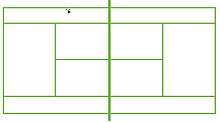10 and Under Tennis
10 and Under Tennis is a program introduced by the United States Tennis Association (USTA) in the summer of 2010 forever changing the way the game of tennis is taught.[1] Upon making the change official in 2012, it modified the format of all USTA and International Tennis Federation (ITF) events involving players of years 10 and younger.[1] The program changes the game making it easier for children to succeed. The objective is to adapt the court, balls, racket, and net to the size and strength level of youth players.[2] These alternations create the opportunity for younger players to spend more time hitting balls rather than chasing them. It allows kids to hone tennis skills and accelerate their development. The hope is that earlier success in tennis will translate to a lifetime of interest in the sport and perhaps set a foundation for generations of more world-class players.
Under the changes made through 10 and Under Tennis, not only are court dimensions smaller, racket shorter, and tennis nets lower but the balls used are larger and have less compression. With a lower compression, balls don’t bounce as high.[3] This keeps them within a younger players strike zone creating more chances to make contact with the ball.
The unique coloring of the balls provides better visual indication of the spin that both that the player and his/her opponent is able to put on the ball. A large part of developing a strong tennis stroke is being able to generate the necessary ball rotation required in each situation. The colorized ball provides immediate feedback to kids letting them know if they executed their stroke properly.
As young players progress in age and ability, the size of the court and balls change as well. The player’s progression through the levels of the 10 and Under Tennis program supports an easier transition to the standard adult game. By the time players evolve to the traditional ball and court dimensions, they will have had more chances to master the nuances of the game than players taking more conventional developmental approaches using standard balls, court sizes, and instruction.
Red Stage 1 (ages 4-6)[4][5]

Ball:
- Color: Red & Yellow
- Material: Foam
- Size: larger than felt red ball
- Compression: n/a
Racket:
- Size: 23 inches or less

Court:
- Singles Dimensions: 36 feet by 18 feet
- Doubles Dimension: n/a
Net:
- Height: 2 feet 9 inches
Scoring:
- Best of 3 games. 7 points per game. First to 7 wins the game.
Goals:
- Developing basic athletic skills as well as eye / hand coordination.
Red Stage 2 (ages 6-8)[4][5]

Ball:
- Color: Red & Yellow
- Material: Felt
- Size: 15% larger than standard yellow balls
- Compression: 25% compression of yellow balls
Racket:
- Size: 23 inches or less

Court:
- Singles Dimensions: 36 feet by 18 feet
- Doubles Dimension: n/a
Net:
- Height: 2 feet 9 inches
Scoring:
- Best of 3 games. 7 points per game. First to 7 wins the game.
Goals:
- Developing basic athletic, racquet, and tennis game skills.
Orange (ages 7-10)[4][5]

Ball:
- Color: Orange & Yellow
- Material: Felt
- Size: standard size
- Compression: 50% compression of yellow balls
Racket:
- Size: 23-25 inches

Court:
- Singles Dimensions: 60 feet by 21 feet
- Doubles Dimension: 60 feet by 27 feet
Net:
- Height: 3 feet at center, 3 feet 6 inches at posts
Scoring:
- Best of 3 sets. The first to win 4 games wins the set. In the third set, the first player to win 7 points wins the set.
Goals:
- Developing tennis athletic, technical, and competitive skills.
Green (ages 11 or older)[4][5]

Ball:
- Color: Green & Yellow
- Material: Felt
- Size: standard size
- Compression: 75% compression of yellow balls
Racket:
- Size: 25-27 inches

Court:
- Singles Dimensions: 78 feet by 27 feet
- Doubles Dimension: 78 feet by 36 feet
Net:
- Height: 3 feet at center, 3 feet 6 inches at posts
Scoring:
- Best of 3 games. 7 points per game, first to 7 wins the game.
Goals:
- Bring together tennis technical, tactical, and physical skills during competition.
Video(s)
Explains 10 and Under Tennis balls: https://www.youtube.com/watch?feature=player_embedded&v=bnf39eDe2KU
Explains 10 and Under Tennis court sizes: https://www.youtube.com/watch?v=3UtEG1Uls4k
External links
- Official 10 and Under Tennis website
- Official United States Tennis Association website
- Official International Tennis Federation website
References
- 1 2 "10 and Under Tennis Rule Change takes effect January 1, 2012". www.usta.com. Retrieved 2015-10-11.
- ↑ "USTA invests $1.3 million in tennis program for youngsters - USATODAY.com". USATODAY.COM. Retrieved 2015-10-11.
- ↑ "QuickStart Tennis | 10 and Under Tennis | USTA Northern". www.northern.usta.com. Retrieved 2015-10-11.
- 1 2 3 4 "Ten and Under Tennis". Ten and Under Tennis. Retrieved 2015-10-11.
- 1 2 3 4 "10 and Under Tennis, tennis tournaments, tennis leagues, adult tennis, senior tennis, junior tennis, community tennis, wheelchair tennis, usta membership, usta officials, tennis players news, tennis blogs, tennis event results, tennis news, tennis players | 10 and Under Tennis | USTA Southern California". www.scta.usta.com. Retrieved 2015-10-11.